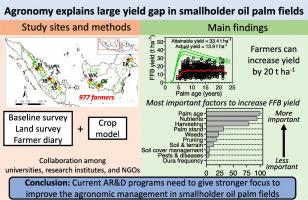Agricultural Systems ( IF 6.1 ) Pub Date : 2023-06-02 , DOI: 10.1016/j.agsy.2023.103689 Juan Pablo Monzon , Ya Li Lim , Fatima A. Tenorio , Rana Farrasati , Iput Pradiko , Hendra Sugianto , Christopher R. Donough , Juan I. Rattalino Edreira , Suroso Rahutomo , Fahmuddin Agus , Maja A. Slingerland , Mink Zijlstra , Shofia Saleh , Fakhrizal Nashr , Denni Nurdwiansyah , Nadib Ulfaria , Nurul L. Winarni , Nurbaya Zulhakim , Patricio Grassini

|
CONTEXT
Palm oil production is a major source of income for millions of smallholders in Indonesia. However, actual yield remains low in relation to the attainable yield. While emphasis has been given to planting material as a factor explaining low yield in smallholder fields, the role of agronomic management has received less attention.
OBJECTIVE
We assessed the role of agronomic management in explaining low oil palm productivity in independent smallholder fields in Indonesia.
METHODS
We quantified yield gaps and their causes using data on fresh fruit bunch (FFB) yield and management practices collected over two years across 977 fields. The yield gap was estimated for each field as the difference between actual and attainable yield. The latter was estimated using a crop model, local weather and field-specific soil and palm age. Statistical techniques were used to identify factors explaining yield gaps.
RESULTS AND CONCLUSIONS
Average yield represented 42% of the attainable yield, with largest yield gaps occurring in young plantations. Our analyses identified agronomic practices explaining yield gaps, including nutrient management, harvest interval, weed control, and pruning. Improved agronomic management can help smallholders increase yield and profit on existing plantations.
SIGNIFICANCE
There is an opportunity to produce more palm oil on current plantation area via better agronomy, generating a positive economic impact at local to national levels, while reducing pressure to clear new land for cultivation. Research & extension programs should be re-oriented to give more emphasis to agronomic management.
中文翻译:

农学解释了小农油棕田的巨大产量差距
语境
棕榈油生产是印度尼西亚数百万小农的主要收入来源。然而,与可达到的产量相比,实际产量仍然很低。虽然人们强调种植材料是小农田低产的一个因素,但农艺管理的作用却很少受到关注。
客观的
我们评估了农艺管理在解释印度尼西亚独立小农田油棕生产力低下的作用。
方法
我们使用两年来在 977 个田地收集的鲜果串 (FFB) 产量和管理实践数据量化了产量差距及其原因。每个田地的产量差距被估计为实际产量和可达到产量之间的差异。后者是使用作物模型、当地天气和特定田地的土壤和棕榈树年龄估算的。统计技术被用来确定解释产量差距的因素。
结果和结论
平均产量占可获得产量的 42%,最大的产量差距出现在年轻的种植园中。我们的分析确定了解释产量差距的农艺实践,包括养分管理、收获间隔、杂草控制和修剪。改进农艺管理可以帮助小农提高现有种植园的产量和利润。
意义
有机会通过更好的农艺在当前的种植园面积上生产更多的棕榈油,在地方和国家层面产生积极的经济影响,同时减少清理新土地进行耕种的压力。研究和推广计划应该重新定位,更加强调农艺管理。











































 京公网安备 11010802027423号
京公网安备 11010802027423号